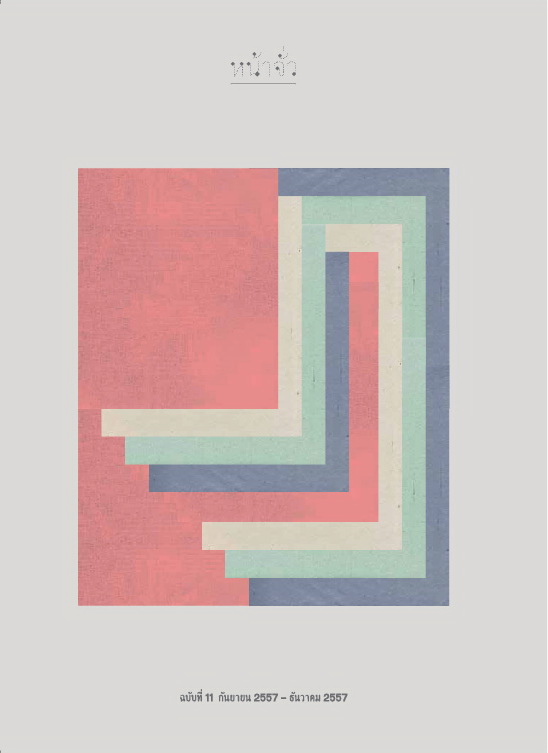สังฆกรรมวิธีในจิตรกรรมฝาผนังวัดปทุมวนาราม/ The Formal Act of Buddhist Monks on Mural Paintings at Wat Pathumwanaram
Main Article Content
Abstract
บทคัดย่อ
บทความเรื่องนี้เป็นการศึกษาวิเคราะห์และอภิปรายเกี่ยวกับสังฆกรรมวิธีที่ปรากฏในเอกสารและจิตรกรรมฝาผนังภายในพระอุโบสถวัดปทุมวนาราม มีวัตถุประสงค์ คือ 1) เพื่อศึกษาความหมายของจิตรกรรมฝาผนังเรื่องสังฆกรรมวิธี วัดปทุมวนารามราชวรวิหาร และ 2) เพื่อศึกษาสังฆกรรมที่ปรากฏในเอกสารและจิตรกรรมฝาผนังและผลสืบเนื่องต่อมา
ผลวิจัยพบว่า สังฆกรรมเป็นหลักในการควบคุมวัตรปฏิบัติของพระสงฆ์ และเป็นสิ่งที่มีความสำคัญยิ่งขึ้นในรัชกาลพระบาทสมเด็จพระจอม-เกล้าเจ้าอยู่หัว ดังปรากฏในหมายรับสั่งต่างๆ คำประกาศ ราชกิจนานุเบกษา และปรากฏในจิตรกรรมฝาผนังพระอารามหลวงที่พระองค์ทรงสร้าง โดยมีวัดปทุมวนารามเป็นหลัก เขียนบริเวณช่องระหว่างหน้าต่าง 12 ห้อง ภาพมีคำจารึกอธิบายภาพเกี่ยวกับสังฆกรรมวิธีตอนต่างๆ ได้แก่ การประชุมปรึกษา หารือของคณะสงฆ์ การขอปริวาสกรรม การสวดอัพภาณกรรม และอุโบสถกรรม ซึ่งอุโบสถกรรมเป็นเรื่องสำคัญของคณะสงฆ์ มีระเบียบในการลงอุโบสถทุกกึ่งปักษ์ พระสงฆ์จะต้องบริสุทธิ์ศีลเข้าร่วมกันฟังพระปาติโมกข์ 227 ข้อ หากมีผู้ใดอาบัติให้แสดงตนและไม่สามารถเข้าร่วมในการทำสังฆกรรมนั้นได้ อุโบสถกรรมเป็นสังฆกรรมสำคัญ เป็นกิจที่พระสงฆ์จะต้องปฏิบัติสม่ำเสมอ เป็นวินัยที่พระบาทสมเด็จพระจอมเกล้าเจ้าอยู่หัวทรงมีพระราชประสงค์ให้พระสงฆ์ปฏิบัติเคร่งครัด ร่วมกับการออกกฎหมายเพื่อชำระพระพุทธศาสนาให้ผู้ที่ละเมิดทั้งวินัยและกฎหมายได้รับการลงโทษ จิตรกรรมฝาผนังเรื่องสังฆกรรมวิธีจึงเป็นสื่อในการย้ำเตือนให้แก่พระสงฆ์และประชาชนตระหนักถึงความสำคัญของสังฆกรรมเพื่อการปฏิบัติที่ถูกต้อง
Abstract
This research has 2 main objectives. The first objective is to study the meaning of the murals about the formal act practices at Wat Pathumwanaram. The second is to study such monastic activities as recorded in historical documents and on mural paintings. Drawing upon documents of King Mongkut’s orders, the Ministry Announcements in the Gazette, and on mural paintings at monasteries that King Mongkut ordered to build, particularly at Wat Pathumwanaram, the paper looked at the practice of the formal act – a monastic practice which was activated in the reign of King Mongkut in order to control behavior of the monks. At the ordination hall of the temple, mural paintings on the inner walls between windows depict various practices of formal act including “Consultation Meeting amongst Monks of Each Monastery”, “Asking a Pariwatsa Karma”, “Prayer a AppannaKarma” and “Uposoth Karma”. As the monastic act which King Mongkut urged monks to routinely practice very fortnight at appointed times, Uposoth Karma was a strictly religious practice which every monk within the viharasima or boundary was expected to attend in order to pray the Pathimokha or monks’ disciplinary codes, 227 stanzas in total. The research suggested that the murals depicting the formal act practices function as a sign to remind monks and citizens to be aware of its importance.

